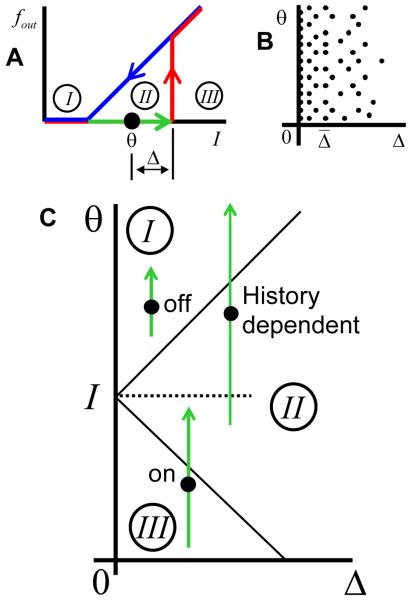Figure 3.
Ensemble of bistable neurons with differential parameters. (A) Example of the input to firing rate relationship for a bistable neuron. The activation (red) and deactivation curves (blue) do not coincide in the bistable range (green). If the input current (I) to the neuron is in the bistable range the firing rate can have two values depending on the previous history. The bistable range is shown by the green arrow, with the threshold for activation denoted by the arrowhead. The threshold for deactivation coincides with the arrow's tail. Such neurons can be described by two parameters: θ and Δ, representing the mean position of the threshold (black dot) and the half-width of hysteresis. The unconditionally OFF, bistable, and unconditionally ON ranges of input are labeled by I, II, and III respectively. (B) We considered an ensemble of many bistable neurons. Each neuron is represented by a point in the parameter space (Δ,θ). The density of neurons is uniform along the vertical θ-axis, while the density decays for lager values of the hysteresis half-width. (C) For a given value of the synaptic current on the inputs of all neurons (I, dotted line) the parameter space is divided into three regions. In the top region the neurons are unconditionally OFF. This region corresponds to the range of inputs labeled by I in (A). Thus for one of such neurons, whose bistable range is shown by the green arrow, the input level (dotted line) is below both thresholds for activation and deactivation, which implies that the neuron is unconditionally OFF. In the bottom region, labeled by III, all the neurons are unconditionally ON, since, as shown for another example neuron, the input is above the threshold for activation. In the middle region (labeled by II) the input current is in the bistable range, as shown for one of the neurons. The firing state of these neurons is therefore history dependent, which implies that they can be either ON or OFF.

